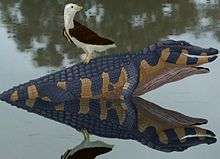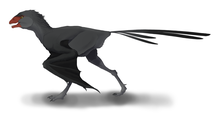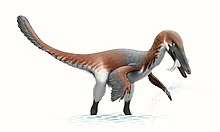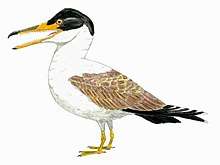Avisaurus
Avisaurus (meaning "bird lizard") is a genus of enantiornithine bird from the Late Cretaceous of North America.[1]
| Avisaurus | |
|---|---|
 | |
| Restoration of Avisaurus and Brachychampsa | |
| Scientific classification | |
| Kingdom: | Animalia |
| Phylum: | Chordata |
| Clade: | †Enantiornithes |
| Family: | †Avisauridae |
| Genus: | †Avisaurus Brett-Surman & Paul, 1985 |
| Type species | |
| †Avisaurus archibaldi Brett-Surman & Paul, 1985 | |
| Species | |
| |
Paleobiology
Avisaurus is known from the humid low-lying swamps, lakes, and river basins of the western shore of the Western Interior Seaway, and from the much more arid uplands between that area and the Cordilleran Overthrust Belt which eventually formed the Rocky Mountains.
Classification
This genus belongs to the enantiornithine family Avisauridae, which also contains similar animals from South America such as Soroavisaurus [2] and Neuquenornis [3] In the Late Cretaceous the Americas were still separated by a branch of the Tethys Ocean.
Avisaurus archibaldi was discovered in the Late Cretaceous Hell Creek Formation of North America (Maastrichtian, from c.70.6-66 million years ago), making it one of the last enantiornithids. It was collected in 1975 in the UCMP locality V73097, in Garfield County, Montana, USA. The holotype is represented by a single fossil of a tarsometatarsus in the collection of the University of California Museum of Paleontology. It has the catalog number UCMP 117600. It was initially described as the left tarsometatarsus of a non-avian theropod by Brett-Surman and Paul in 1985. It was later redescribed as the right tarsometatarsus of an enantiornithine bird by Chiappe in 1992.[4]
The specimen has a maximum length of 73.9 mm, making it one of the largest known tarsometatarsi of an enantiornithine.[5]
The species name honors J. David Archibald, its discoverer, from The University of California, Berkeley.
Avisaurus gloriae Varrichio and Chiappe 1995,[5] discovered in the late Campanian Upper Two Medicine Formation of Glacier County, Montana, USA, was renamed Gettyia by Atterholt et al. (2018).[6]
The Brett-Surman paper
The paper by Brett-Surman and Paul in 1985 explicitly considered the possibility that A. archibaldi was an enantiornithine. The authors described and named UCMP 117600 formally, but they looked at other enantiornithine material, including the "metatarsus" PVL 4690 from Argentina. The authors assigned this latter fossil to Avisaurus sp. From this they concluded that members of the genus Avisaurus existed in both North and South America in the Late Cretaceous. Moreover, the authors concluded that the length/width ratio and degree of metacarpal fusion of these bones were more like those of non — avian dinosaurs. A terrestrial dinosaur genus in both continents would then support Brett — Surman's theory that there had been a land connection between the two continents.[7]
Further discoveries and further study by Chiappe showed that all of the material belonged to enantiornithine birds, and PVL 4690 was given its own genus Soroavisaurus.[4]
References
- PaleoBiology Database: Avisaurus, basic info
- Chiappe, Luis M. (1993) " Enantiornithine (Aves) Tarsometatarsi from the Cretaceous Lecho Formation of Northwestern Argentina" American Museum Novitates December 27, 1993 Number 3083 pp. 1-2
- Chiappe, Luis M., Calvo, Jorge O. (1994) "Neuquenornis volans, a New Late Cretaceous Bird (Enantiornithes: Avisauridae) from Patagonia, Argentina" "Journal of Vertebrate Paleontology" June 22, 1994 Volume 14 No. 2 pp.230-246.
- Chiappe, Luis M. (1992) "Enantiornithine (Aves) Tarsometatarsi and the Avian Affinities of the Late Cretaceous Avisauridae" "Journal of Vertebrate Paleontology" September 3, 1992, Volume 12 no. 3 pp. 344-350
- Varrichio, David J., Chiappe, Luis M. (1995) "A New Enantiornithine Bird From the Upper Cretaceous Two medicine Formation of Montana" " Journal of Vertebrate Paleontology" March 14, 1995, Vol. 15, no. 1, pp. 201 - 204
- Atterholt J, Hutchison JH, O’Connor JK. (2018) The most complete enantiornithine from North America and a phylogenetic analysis of the Avisauridae. PeerJ 6:e5910 https://doi.org/10.7717/peerj.5910
- Brett-Surman, Michael K., Paul, Gregory S. (1985) "A new family of bird-like dinosaurs linking Laurasia and Gondwanaland." "Journal of Vertebrate Paleontology" 5(2): 133-138.
Further reading
- Brett-Surman, Michael K. & Paul, Gregory S. (1985): A new family of bird-like dinosaurs linking Laurasia and Gondwanaland. J. Vertebr. Paleontol. 5(2): 133–138.
- Cambra-Moo, Oscar; Delgado Buscalioni, Ángela; Cubo, Jorge; Castanet, Jacques; Loth, Marie-Madeleine; de Margerie, Emmanuel & de Ricqlès, Armand (2006): Histological observations of Enantiornithine bone (Saurischia, Aves) from the Lower Cretaceous of Las Hoyas (Spain). C. R. Palevol 5(5): 685–691. doi:10.1016/j.crpv.2005.12.018 PDF fulltext
- Chiappe, Luis M. (1993): Enantiornithine (Aves) Tarsometatarsi from the Cretaceous Lecho Formation of Northwestern Argentina. American Museum Novitates 3083: 1-27. [English with Spanish abstract] PDF fulltext



.png)





.png)


